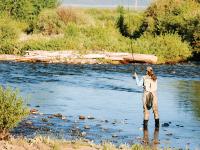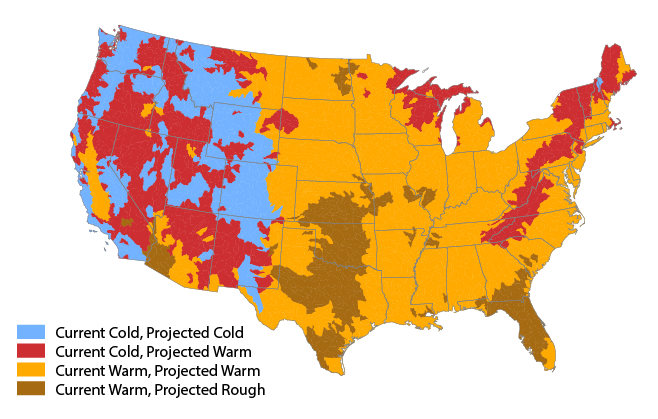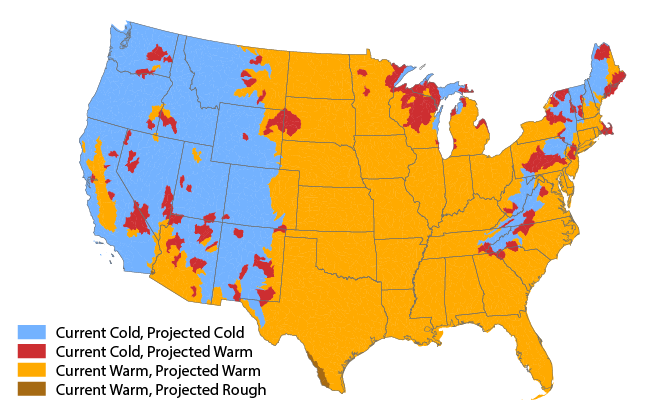Climate Action Benefits: Freshwater Fish

Freshwater fishing is an important recreational activity that contributes significantly to local economies in many parts of the country. Most fish species thrive only in certain ranges of water temperature and stream flow conditions. For example, trout and salmon can only tolerate coldwater streams, while shad and largemouth bass thrive in warmwater habitats (see below infographic). Climate change threatens to disrupt these habitats and affect certain fish populations through higher temperatures and changes in river flow.21
On this page:
Additional information:
Key Findings
- Warming waters and changes in stream flow from climate change will alter the distribution of freshwater fisheries across the country. Without global GHG mitigation, coldwater species are projected to be replaced in many areas by less economically valuable fisheries over the course of the 21st century, especially in the Mountain West and Appalachia.
- Habitat suitable for coldwater fisheries is estimated to decline nationally by approximately 62% through 2100 under the Reference, but by only 12% under the Mitigation scenario. Global GHG mitigation is projected to preserve coldwater habitat in most of Appalachia and the Mountain West.
- GHG mitigation avoids an estimated $380 million to $1.5 billion in total recreational fishing damages through 2100 compared to the Reference (discounted at 3%).
Risks of Inaction
Without GHG mitigation, climate change is projected to have a significant impact on freshwater fishing in the contiguous U.S. Increasing stream temperatures and changes in stream flow are likely to transform many habitats that are currently suitable for coldwater fish into areas that are only suitable for warmwater species that are less recreationally valuable. Under the IGSM-CAM climate projections, coldwater fisheries are estimated to be limited almost exclusively to the mountainous West in 2100, and would almost disappear from Appalachia. In addition, substantial portions of Texas, Oklahoma, Kansas, and Florida would shift from warmwater to rough habitat (Figure 1). Overall, unmitigated climate change is projected to result in a 62% decline in coldwater fish habitat by 2100, which includes approximately 440,000 acres of lost stream habitat. Meanwhile, warmwater and rough stream habitats are projected to increase by 1.3 million and 450,000 acres, respectively. The projected loss of coldwater fish habitat and expansion of warmwater and rough fisheries are consistent with the findings of the assessment literature.22,23
Figure 1. Projected Impact of Unmitigated Climate Change on Potential Freshwater Fish Habitat in 2100
 Change in distribution of areas where stream temperature supports different fisheries under the Reference scenario using the IGSM-CAM climate model. Results are presented for the 8-digit hydrologic unit codes (HUCs) of the contiguous U.S.
Change in distribution of areas where stream temperature supports different fisheries under the Reference scenario using the IGSM-CAM climate model. Results are presented for the 8-digit hydrologic unit codes (HUCs) of the contiguous U.S.download the figure; download the data
Figure 2. Projected Impact on Potential Freshwater Fish Habitat in 2100 with Global GHG Mitigation
 Change in distribution of areas where stream temperature supports different fisheries under the Mitigation scenario using the IGSM-CAM climate mode. Results are presented for the 8-digit HUCs of the contiguous U.S.
Change in distribution of areas where stream temperature supports different fisheries under the Mitigation scenario using the IGSM-CAM climate mode. Results are presented for the 8-digit HUCs of the contiguous U.S.download the figure; download the data
Reducing Impacts through GHG Mitigation
Global GHG mitigation is projected to prevent much of the loss of coldwater fish habitat that occurs in the Reference (Figure 2). Although coldwater stream habitat will likely still be reduced under the Mitigation scenario (by approximately 85,000 acres by 2100), mitigation avoids approximately 81% of the losses incurred under the Reference, preserving an area equal to approximately 360,000 acres of suitable stream habitat nationally. This habitat supports valuable recreational fishing, especially in Appalachia and large areas of the Mountain West. Also, fewer acres are converted to less economically valuable warmwater and rough fisheries under the Mitigation scenario than under the Reference. Specifically, stream habitat suitable for warmwater and rough fisheries increase by 450,000 and 13,000 acres, respectively, under the Mitigation scenario, which is 36% and 3% of the expansions estimated under the Reference.
Compared to the Reference, the Mitigation scenario provides economic benefits of approximately $1.5 billion through 2100 for coldwater fishing only, and $380 million when all three freshwater fishery types (cold, warm, and rough) are considered (discounted at 3%). These results rely upon climate projections from the IGSM-CAM, which projects a relatively wetter future for most of the U.S. compared to the MIROC climate model. The projected benefits of global GHG mitigation through 2100 are lower with the drier MIROC model (not shown) for coldwater fishing only, at approximately $1.2 billion, but higher when all three fisheries are considered, at approximately $1.5 billion (discounted at 3%).24
Approach
The CIRA analysis assesses the impacts of climate change on the distribution of habitat suitable for freshwater fish across the U.S. and estimates the economic implications of these changes. Water temperature changes are simulated for the CIRA emissions scenarios using the IGSM-CAM and MIROC climate models to estimate changes in suitable habitat (in stream acres) for three types of freshwater fisheries: cold, warm, and rough (species tolerant to warmest stream temperatures). Each fishery type represents a categorization of individual species based on their tolerance for different river and stream water temperatures. This analysis does not evaluate impacts to fisheries in lakes and reservoirs, which are vulnerable to climate change in different ways compared to streams and rivers.25 As shown at the bottom of this section, the coldwater fish guild contains species that are the least tolerant to increasing stream temperatures, and are therefore the most vulnerable to climate change.
Results from habitat modeling considering projected changes in both water temperature and streamflow serve as input to an economic model to analyze the impacts of habitat change on the value of recreational fishing. The model estimates fishing behavior as the likelihood that an adult in a particular state is an angler and the likelihood that an angler fishes for species in each fishery type. The fishing value for each fishery type is derived by multiplying the number of fishing days by the value of a fishing trip.26
As the implications of changes to the distribution of freshwater fisheries extend beyond recreational use by humans, this analysis underestimates the economic benefits of GHG mitigation.
For more information on the CIRA approach and results for the freshwater fish sector, please refer to Lane et al. (2014)27 and Jones et al. (2012).28

